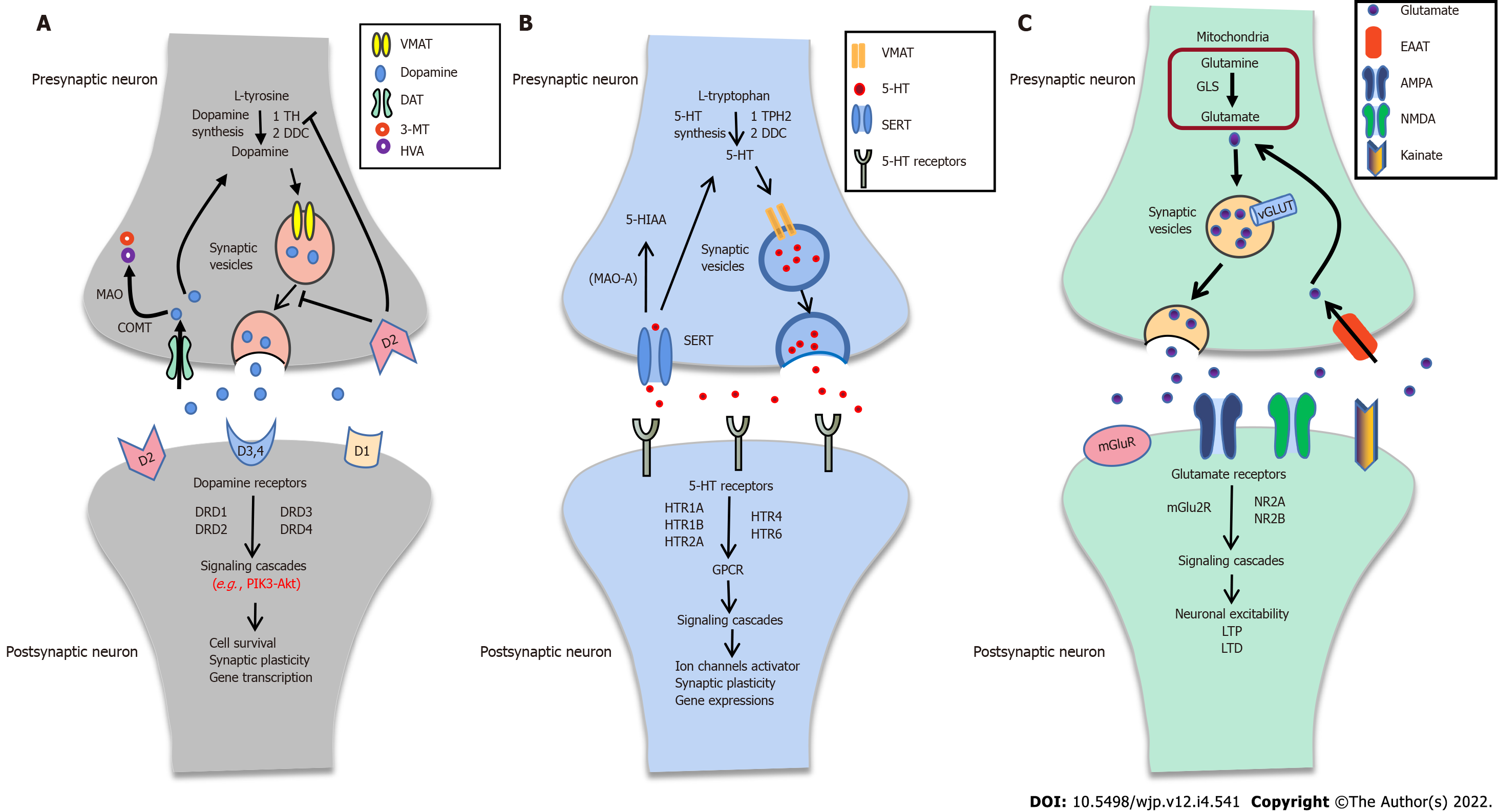Copyright
©The Author(s) 2022.
World J Psychiatry. Apr 19, 2022; 12(4): 541-557
Published online Apr 19, 2022. doi: 10.5498/wjp.v12.i4.541
Published online Apr 19, 2022. doi: 10.5498/wjp.v12.i4.541
Figure 2 Neurotransmission in dopaminergic, serotonergic, and glutamatergic neurons.
Each pathway step is supplemented with associated genes according to KEGG. A: Dopaminergic pathway. Dopamine is synthesized from tyrosine through two steps: (1) Tyrosine hydroxylase catalyzes the tyrosine to L-DOPA by hydroxylation; and (2) L-DOPA converts to dopamine by DOPA decarboxylase (DDC). Dopamine can be stored into synaptic vesicles by the vesicular monoamine transporters and release to the synaptic cleft. Dopamine as a neurotransmitter, can directly bind to its receptor to activate downstream signaling cascades and influence cell survival, synaptic plasticity, and gene transcription. Besides, dopamine also can be transported back to the presynaptic membrane by the DAT and eliminated. DRD2, an auto-receptor, can inhibit the release of dopamine in the presynaptic membrane; B: Serotoninergic (5-HTergic) pathway. The synthesis of 5-HT needs two enzymes: Tryptophan hydroxylase and DDC. After synthesizing, 5-HT can be transported into synaptic vesicles and release to the synaptic cleft. Some of the 5-HT directly binds to its receptors (e.g., HTR1A, HTR1B, HTR2A, HTR4, and HTR6), activates downstream signaling pathway to activate ion channels, and influences synaptic plasticity and gene expressions, and others are re-uptaken into the presynaptic membrane by the serotonin transporter; C: Glutamatergic pathway. Glutamate is converted from glutamine by phosphate-activated glutaminase in mitochondria and packaged into synaptic vesicles by vesicular glutamate transporters. Sequentially, the glutamate is released to the synaptic cleft and binds to the glutamate receptors, and then activates the downstream pathway or is repacked into presynaptic membrane by excitatory amino acid transporters. Signaling cascade activation might lead to the change of neural excitability and finally has effects on long-term potentiation or long-term depression. MAO: Monoamine oxidase; COMT: Catechol O-methyltransferase; 3-MT: 3-Methoxytyramine; HVA: Homovanillic acid; 5-HIAA: 5-Hydroxy indole acetic acid; EAATs: Excitatory amino acid transporters; 5-HT: Serotonin or 5-hydroxytryptamine; GPCR: G protein-coupled receptor; GLS: Glutaminase; NMDA: N-methyl-D-aspartate receptor; AMPA: α-Amino-3hydroxy-5methyl-4-isox-azolepropionic acid; mGluR: Metabotropic glutamate receptor; LTP: Long-term potentiation; LTD: Long-term depression.
- Citation: Wu XL, Yan QJ, Zhu F. Abnormal synaptic plasticity and impaired cognition in schizophrenia. World J Psychiatry 2022; 12(4): 541-557
- URL: https://www.wjgnet.com/2220-3206/full/v12/i4/541.htm
- DOI: https://dx.doi.org/10.5498/wjp.v12.i4.541









